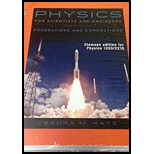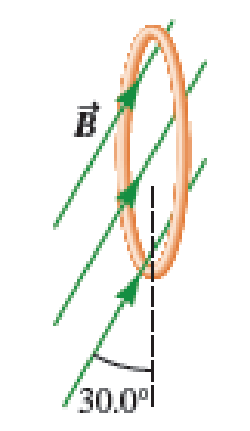
A constant magnetic field of 0.275 T points through a circular loop of wire with radius 3.50 cm as shown in Figure P32.1.
a. What is the magnetic flux through the loop?
b. Is a current induced in the loop? Explain.

FIGURE P32.1
(a)
The magnetic flux through the loop.
Answer to Problem 1PQ
The magnetic flux through the loop is
Explanation of Solution
Write the expression for the magnetic flux through the loop.
Here,
Write the expression for the area of the loop.
Here,
Substitute the above equation in equation (I) to find
Substitute
Conclusion:
Thus, the magnetic flux through the loop is
(b)
Whether the current induced in the loop.
Answer to Problem 1PQ
No current is induced in the loop because there is no change in the flux passing through the loop.
Explanation of Solution
Since the magnetic flux linked with the loop is constant, there is no change in the magnetic flux associated with the loop of the wire. So, there is no current induced in the loop.
Conclusion:
Thus, no current is induced in the loop.
Want to see more full solutions like this?
Chapter 32 Solutions
Physics for Scientists and Engineers: Foundations and Connections
- 220 V is supplied to 800 primary turns of an autotransformer. What will the outputvoltage be across 200 secondary turns? 2. A filament transformer has a turns ratio of 1:20. What current must be supplied to theprimary windings if 5 A is required by the filament? 3. The filament transformer in the previous question is supplied with 150 V to theprimary side. What is the secondary voltage? 4. 440 V is supplied to 1000 primary turns of an autotransformer. If the desired outputvoltage is 100 V how many secondary turns must be tapped?arrow_forward220 volts is supplied across 1200 winding of the primary coil of the autotransformer.If 1650 windings are tapped, what voltage will be supplied to the primary coil of thehigh-voltage transformer?2. A kVp meter reads 86 kVp and the turns ratio of the high-voltage step-up transformeris 1200. What is the true voltage across the meter?3. The supply voltage from the autotransformer to the filament transformer is 60 volts. If theturns ratio of the filament transformer is 1/12, what is the filament voltage?4. If the current in the primary side of the filament transformer in question 3 were 0.5 A,what would be the filament current?5. The supply to a high-voltage step-up transformer with a turns ratio of 550 is 190 volts.What is the voltage across the x-ray tube?arrow_forward220 V is supplied to 800 primary turns of an autotransformer. What will the outputvoltage be across 200 secondary turns? 2. A filament transformer has a turns ratio of 1:20. What current must be supplied to theprimary windings if 5 A is required by the filament? 3. The filament transformer in the previous question is supplied with 150 V to theprimary side. What is the secondary voltage? 4. 440 V is supplied to 1000 primary turns of an autotransformer. If the desired outputvoltage is 100 V how many secondary turns must be tapped?arrow_forward
- Assume ax(u) is constant, then show thatarrow_forwardOne strain of bacteria was found to have a membrane potential of -120 mVmV at a pHpH of 7.5. A bacterium can be modeled as a 1.5-μmμm-diameter sphere. How many positive ions are needed on the exterior surface to establish this membrane potential? (There are an equal number of negative ions on the interior surface.) Assume that the membrane properties are the same as those of mammalian cells.arrow_forwardQ: Draw the fabrication layers of a transistor with metal and semiconductor MS junction (Schottkyj unction).arrow_forward
 Physics for Scientists and Engineers: Foundations...PhysicsISBN:9781133939146Author:Katz, Debora M.Publisher:Cengage Learning
Physics for Scientists and Engineers: Foundations...PhysicsISBN:9781133939146Author:Katz, Debora M.Publisher:Cengage Learning Principles of Physics: A Calculus-Based TextPhysicsISBN:9781133104261Author:Raymond A. Serway, John W. JewettPublisher:Cengage Learning
Principles of Physics: A Calculus-Based TextPhysicsISBN:9781133104261Author:Raymond A. Serway, John W. JewettPublisher:Cengage Learning
 Physics for Scientists and EngineersPhysicsISBN:9781337553278Author:Raymond A. Serway, John W. JewettPublisher:Cengage Learning
Physics for Scientists and EngineersPhysicsISBN:9781337553278Author:Raymond A. Serway, John W. JewettPublisher:Cengage Learning Physics for Scientists and Engineers with Modern ...PhysicsISBN:9781337553292Author:Raymond A. Serway, John W. JewettPublisher:Cengage Learning
Physics for Scientists and Engineers with Modern ...PhysicsISBN:9781337553292Author:Raymond A. Serway, John W. JewettPublisher:Cengage Learning Physics for Scientists and Engineers, Technology ...PhysicsISBN:9781305116399Author:Raymond A. Serway, John W. JewettPublisher:Cengage Learning
Physics for Scientists and Engineers, Technology ...PhysicsISBN:9781305116399Author:Raymond A. Serway, John W. JewettPublisher:Cengage Learning





